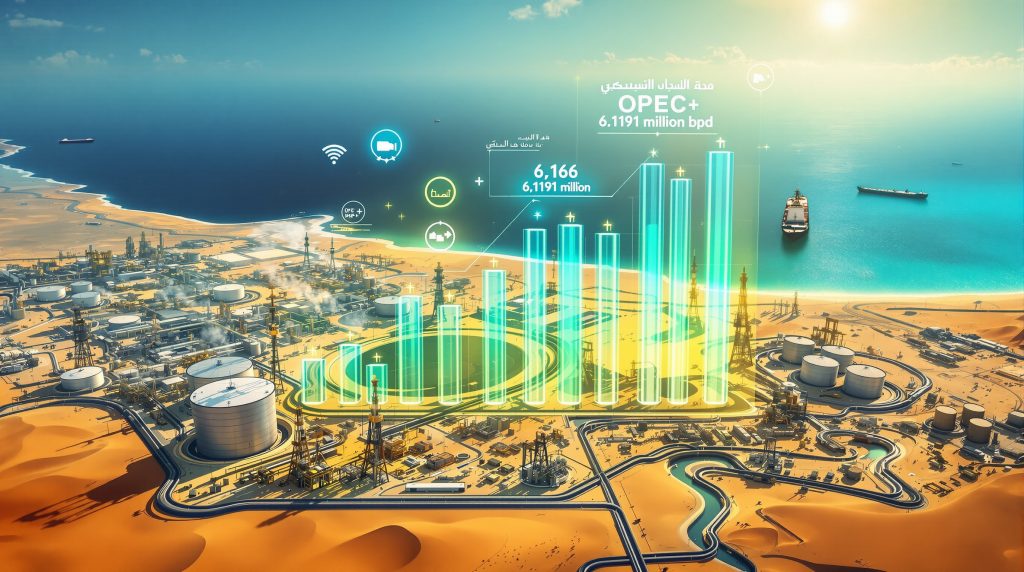Understanding the Kingdom's Strategic Market Position
Saudi Arabia crude oil exports increase has emerged as a defining trend throughout 2025, showcasing the kingdom's sophisticated approach to global energy market management. The nation has positioned itself as a critical stabilising force in international crude markets while simultaneously pursuing ambitious economic diversification goals under its Vision 2030 initiative.
The kingdom's enhanced export capabilities reflect careful coordination with OPEC+ partners and strategic timing aligned with global demand patterns. Current market dynamics, including oil prices hovering around $62.57 per barrel for Brent crude and $58.55 for WTI, present both opportunities and challenges for Saudi export optimisation strategies.
Saudi Arabia maintains approximately 12 million barrels per day of maximum sustainable production capacity, providing substantial flexibility to adjust export volumes based on market conditions and strategic objectives. This capacity advantage enables the kingdom to serve as OPEC's primary swing producer, capable of rapidly responding to global supply disruptions or demand fluctuations.
How Much Have Saudi Crude Exports Actually Increased?
Recent data confirms substantial growth in Saudi Arabia crude oil exports increase during 2025, with the kingdom capitalising on improved market conditions and coordinated OPEC+ policy adjustments. Export levels demonstrate consistent upward momentum, reflecting strategic decisions to maximise market share while supporting global energy security requirements.
Monthly Export Performance Metrics:
- April 2025: Export volumes reached 6.166 million barrels per day
- May 2025: Exports increased to 6.191 million barrels per day, marking a three-month peak
- August 2025: Saudi Arabia's crude oil exports surged by an additional 400,000 barrels per day
The 400,000 barrel per day increase in August represents a significant market development, demonstrating Saudi Arabia's commitment to meeting growing global demand while maintaining price stability. This expansion occurred during a period when international crude prices remained relatively stable, suggesting strategic market management rather than opportunistic price-driven decisions.
Historical context reveals that Saudi Arabia exported an average of 7.5 million barrels per day in 2023, indicating that current export levels remain below previous peak capacity. This measured approach allows the kingdom to maintain additional export flexibility while supporting OPEC+ coordination objectives.
What Role Does OPEC+ Play in Export Expansion?
The Organization of Petroleum Exporting Countries and its allies have implemented a carefully orchestrated approach to global supply management since early 2025. However, the OPEC meeting impact on production decisions involves systematically rolling back previous production constraints while maintaining market stability through disciplined capacity additions.
OPEC+ Strategic Implementation Timeline:
| Period | Policy Action | Market Impact |
|---|---|---|
| Early 2024 | Voluntary cuts of 2.2 million bpd implemented | Price stabilisation |
| April 2025 | Initial production increase rollback | Gradual supply addition |
| May-August 2025 | Continued capacity restoration | Market share defence |
The OPEC+ alliance, comprising 13 OPEC members and 10 non-OPEC partners, collectively controls approximately 40% of global oil production. This substantial market influence enables coordinated policy implementation that balances member nation revenue requirements with international energy security considerations.
Saudi Arabia's export expansion occurs within this broader OPEC+ framework, ensuring that increased Saudi shipments complement rather than compete with other member nations' export strategies. The Joint Ministerial Monitoring Committee conducts monthly assessments to fine-tune production quotas based on evolving market conditions and compliance rates.
How Do Production Increases Support Export Growth?
Saudi Arabia's domestic crude oil production expansion provides the foundation for enhanced export capabilities, with systematic capacity increases supporting growing international shipment commitments. Nevertheless, this approach differs from the US oil production decline observed elsewhere, with production growth following a measured approach that balances rapid market response with sustainable long-term extraction practices.
Production Capacity Development:
- April 2025: Total production reached 9.005 million barrels per day
- May 2025: Output increased to 9.184 million barrels per day
- September 2025: Production expanded further to 9.966 million barrels per day
The kingdom's production increases occur primarily through three major field systems: Ghawar (the world's largest oil field), Safaniyah, and Khurais. These facilities provide the technical infrastructure necessary to support rapid production adjustments while maintaining crude quality specifications demanded by international markets.
Furthermore, Saudi Arabia historically maintains 1.5 to 2 million barrels per day of spare production capacity, ensuring flexibility to respond to unexpected market disruptions or demand surges. This buffer capacity represents a critical component of global energy security architecture, providing confidence to international markets during periods of geopolitical uncertainty.
Technical coordination between upstream production facilities and downstream export infrastructure requires 2-4 weeks for full implementation of production changes. This operational timeline influences Saudi export planning and demonstrates the sophisticated logistics management required for large-scale crude oil operations.
What Economic Factors Influence Export Strategy?
Saudi Arabia's export decisions operate within complex economic parameters that balance immediate revenue requirements against long-term strategic positioning. Current market conditions present particular challenges, with oil price stagnation affecting global pricing dynamics and oil prices trading below the kingdom's fiscal sustainability thresholds.
Critical Economic Metrics:
- Current Brent crude price: $62.57 per barrel (as of October 2025)
- Current WTI crude price: $58.55 per barrel
- Saudi fiscal breakeven estimate: $80-85 per barrel (IMF 2024 assessment)
- Government revenue dependency: 75-80% from petroleum exports
The gap between current oil prices and fiscal breakeven requirements creates pressure for volume optimisation strategies. Saudi Arabia must balance export volume increases with price support objectives, requiring sophisticated market timing and coordination with international partners.
"Current pricing conditions necessitate strategic volume management to optimise total revenue generation while maintaining long-term market positioning advantages."
Revenue Diversification Progress:
- Public Investment Fund growth: From $150 billion (2015) to over $700 billion (2024)
- Non-oil GDP target: 5.3% annual growth under Vision 2030
- Oil dependency reduction goal: From 50% to 30% of GDP by 2030
These diversification initiatives require substantial capital investment, much of which depends on maximising petroleum export revenues during the transition period. Export strategy therefore serves dual purposes of immediate fiscal support and long-term economic transformation funding.
How Does Export Growth Align with Vision 2030?
Saudi Arabia crude oil exports increase occurs alongside ambitious economic diversification initiatives under Vision 2030, creating a strategic balance between current revenue maximisation and future economic transformation. This dual approach recognises that petroleum revenues remain essential for funding diversification projects while building alternative economic foundations.
Vision 2030 Strategic Components:
- Economic diversification: Reducing petroleum dependency from current levels to 30% of GDP
- Megaproject development: NEOM, Qiddiya, and Red Sea Project initiatives
- Private sector growth: Expanding non-oil economic participation
- Tourism development: Targeting 30 million tourists annually by 2030
The kingdom's approach demonstrates sophisticated economic planning that leverages current petroleum advantages to build future competitive positions in technology, tourism, renewable energy, and advanced manufacturing sectors. Furthermore, the ongoing development of Saudi exploration licenses provides critical funding for these transformation initiatives.
Strategic Timeline Coordination:
- Short-term (2025-2027): Maximise crude export revenues while maintaining market share
- Medium-term (2028-2030): Gradual economic diversification with continued petroleum sector strength
- Long-term (post-2030): Sustainable economic model with reduced oil dependency
According to World Bank analysis, Saudi Arabia has achieved significant progress in economic reforms while recognising that petroleum revenues remain critical for funding diversification initiatives during the transition period. This phased approach enables systematic economic transformation without compromising fiscal stability.
What Market Dynamics Drive Export Decisions?
Global energy market conditions significantly influence Saudi export strategies, requiring continuous analysis of demand patterns, competitive positioning, and geopolitical developments. The kingdom must navigate complex international relationships while optimising export revenue and maintaining strategic partnerships, particularly given ongoing oil price movements influenced by various factors.
Key Market Influence Factors:
- Global oil demand (2024): 102.9 million barrels per day (IEA projection)
- Asian market concentration: 60-65% of Saudi exports to Asia-Pacific region
- Primary Asian customers: China, Japan, South Korea, and India
- Competition dynamics: U.S. shale production, Russian crude flows, regional suppliers
China's strategic petroleum reserve policies significantly impact Saudi export planning, as Chinese crude import patterns influence both volume requirements and pricing negotiations. The kingdom maintains flexible export arrangements to accommodate Chinese demand fluctuations while serving other major Asian markets.
Regional Geopolitical Considerations:
- Red Sea shipping security: Impact on transportation routes and costs
- Middle East stability: Regional tensions affecting production and export operations
- International sanctions: Effects on competitive crude flows from other producers
- Energy transition policies: Long-term demand projections in major importing countries
Saudi official selling prices (OSP) strategy reflects these complex market dynamics, with monthly price adjustments designed to maintain competitive positioning while optimising revenue generation. The kingdom's pricing decisions influence broader international crude price benchmarks and trading patterns.
How Do Export Increases Impact Global Markets?
Saudi Arabia's enhanced crude oil exports contribute substantially to global supply availability, potentially influencing international price dynamics and energy security frameworks for importing nations. The kingdom's export decisions carry significant weight in international energy markets due to Saudi Arabia's position as the world's largest crude exporter.
Global Market Impact Analysis:
- OPEC+ spare capacity: 5-6 million barrels per day total (2024 estimates)
- Saudi capacity dominance: Majority holder of global spare production capacity
- Price elasticity impact: 1 million bpd supply increase typically affects prices by $2-5 per barrel
- Market share maintenance: Strategic positioning against competitive producers
Energy market analysts suggest that increased Saudi exports during periods of price weakness may indicate strategic market share defence rather than pure revenue maximisation. This approach reflects long-term competitive positioning aimed at maintaining Saudi Arabia's dominant market position through energy transition periods.
Strategic Petroleum Reserve Implications:
- U.S. SPR policies: American strategic reserve management affecting demand patterns
- Chinese reserve building: Strategic inventory accumulation impacting purchase timing
- Indian energy security: Growing strategic reserve capacity influencing import patterns
- European supply diversification: Reduced Russian dependence creating new demand patterns
The 400,000 barrel per day export increase in August 2025 demonstrates Saudi Arabia's ability to rapidly respond to market conditions while maintaining price stability. This flexibility provides confidence to international markets and supports global energy security during periods of geopolitical uncertainty.
What Infrastructure Supports Export Expansion?
Saudi Arabia's ability to increase crude oil exports relies on sophisticated infrastructure systems including production facilities, pipeline networks, marine terminals, and storage capabilities. Recent infrastructure investments support sustained export growth while maintaining operational flexibility for future capacity expansion.
Critical Infrastructure Components:
| Facility Type | Capacity | Strategic Importance |
|---|---|---|
| Export terminals (Ras Tanura, Ju'aymah, Yanbu) | 10+ million bpd combined | Primary export gateways |
| East-West Pipeline (Petroline) | 5 million bpd transport | Red Sea access |
| Crude oil storage | 250-300 million barrels | Operational flexibility |
| Domestic refining | 2.9 million bpd capacity | Domestic supply security |
The Abqaiq processing facility, recognised as the world's largest crude oil processing centre, serves as a critical hub for preparing various crude grades for international export. This facility processes crude from multiple field sources and maintains quality specifications required by different international markets.
Technical Infrastructure Advantages:
- Master Gas System: Associated gas processing for value maximisation
- Marine terminals: Deep-water berths accommodating Very Large Crude Carriers (VLCCs)
- Quality control systems: Maintaining crude specifications for premium pricing
- Digitalisation upgrades: Advanced monitoring and optimisation technologies
Storage capacity of 250-300 million barrels provides operational flexibility for export timing optimisation, allowing Saudi Arabia to accumulate inventory during high production periods and release supplies during peak demand or price optimisation windows.
Recent infrastructure expansion projects focus on enhancing export terminal efficiency, expanding pipeline capacity, and implementing advanced digital monitoring systems. These improvements support both current export volume increases and future capacity expansion requirements.
What Future Trends May Influence Export Patterns?
Several emerging factors could significantly shape Saudi Arabia crude oil exports increase trajectory beyond 2025, including technological developments, environmental considerations, and evolving global energy transition dynamics. The kingdom's export strategy must account for these long-term trends while maintaining current revenue generation capabilities.
Energy Transition Timeline Implications:
- Global oil demand peak: IEA Net Zero scenario projects demand peaking before 2030
- Electric vehicle impact: Bloomberg NEF projects EVs displacing 6.5 million bpd oil demand by 2030
- Renewable energy growth: Accelerating deployment potentially reducing fossil fuel demand
- Carbon policy developments: International climate agreements affecting long-term demand
Saudi Strategic Adaptations:
- Petrochemical integration: Expanding chemical production to 4 million bpd crude processing by 2030
- Hydrogen development: Blue hydrogen and blue ammonia export potential
- Carbon management: Carbon capture and storage deployment for emissions reduction
- Technology advancement: Enhanced oil recovery and CO2 injection methods
The kingdom's petrochemical expansion represents a strategic hedge against declining transportation fuel demand, converting crude oil into higher-value chemical products with more resilient long-term demand profiles. Moreover, according to Saudi Arabia's trading economics data, Saudi Aramco's integration strategy aims to process 4 million barrels per day of crude into chemicals by 2030.
Regulatory and Policy Considerations:
- Carbon border adjustments: EU and potential other jurisdictions implementing carbon tariffs
- Climate policy evolution: COP agreement implementations affecting international trade
- Technology disruption: Advanced extraction methods and alternative fuel development
- Geopolitical shifts: Changing international energy security priorities
Scenario Planning Framework:
- Optimistic scenario: Gradual energy transition maintaining oil demand through 2035
- Base case scenario: Steady demand decline beginning 2030 with petrochemical offset
- Pessimistic scenario: Accelerated transition reducing crude demand significantly by 2030
Saudi Arabia's export strategy incorporates flexible planning approaches that can adapt to different transition scenarios while maximising value from petroleum resources during the transition period. This adaptive strategy ensures continued relevance in evolving global energy markets.
Strategic Implications for Global Energy Markets
Saudi Arabia crude oil exports increase in 2025 represents sophisticated market management that balances immediate revenue optimisation with long-term strategic positioning in evolving global energy markets. The kingdom's coordinated approach with OPEC+ partners demonstrates commitment to market stability while maximising export opportunities during favourable demand conditions.
The substantial production and export increases, from 6.166 million barrels per day in April to peak levels exceeding 6.191 million barrels per day in May, with an additional 400,000 barrels per day surge in August, represent significant market supply additions that support both domestic fiscal requirements and international energy security frameworks.
Key Strategic Outcomes:
- Market share defence: Maintaining competitive positioning against alternative suppliers
- Revenue optimisation: Balancing volume growth with price stability objectives
- Infrastructure utilisation: Maximising return on substantial export infrastructure investments
- Geopolitical influence: Strengthening international partnerships through reliable supply relationships
Current market conditions, with Brent crude at $62.57 per barrel trading below Saudi fiscal breakeven estimates of $80-85 per barrel, necessitate volume-focused strategies to optimise total revenue generation. The kingdom's ability to increase exports during challenging price environments demonstrates operational flexibility and strategic market management capabilities.
Looking ahead, Saudi Arabia's export strategy will likely continue balancing immediate petroleum revenue maximisation with broader economic diversification objectives under Vision 2030. This dual approach ensures the kingdom maintains its crucial role in global energy markets while systematically building alternative economic foundations for sustainable long-term prosperity.
The integration of traditional petroleum export excellence with emerging energy technologies, including hydrogen development and petrochemical expansion, positions Saudi Arabia to remain a dominant energy supplier throughout the global energy transition period and beyond.
Looking to Capitalise on Energy Market Dynamics?
Discovery Alert's proprietary Discovery IQ model delivers real-time alerts on significant ASX mineral discoveries, providing subscribers with actionable insights into critical resource opportunities including energy minerals and battery metals. Stay ahead of market-moving discoveries by exploring Discovery Alert's dedicated discoveries page, showcasing historic examples of exceptional returns, and begin your 30-day free trial today to secure your competitive advantage in resource investing.




